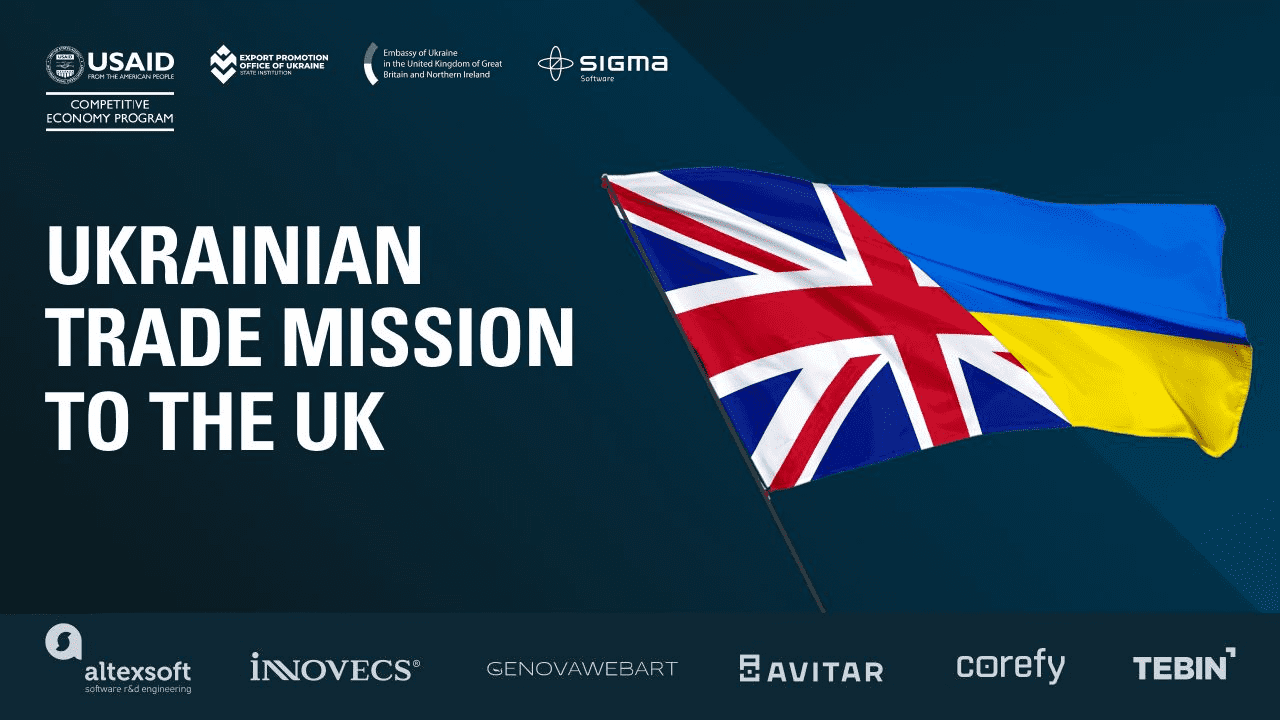What does this agreement mean for Ukraine?
How do we implement the agreements when we talk about IT services?
Thank you for reaching out to Sigma Software!
Please fill the form below. Our team will contact you shortly.
Sigma Software has offices in multiple locations in Europe, Northern America, Asia, and Latin America.

USA

Sweden

Germany

Canada

Israel

Singapore

UAE

Australia

Austria

Ukraine

Poland

Argentina

Brazil

Bulgaria

Colombia

Czech Republic

Hungary

Mexico

Portugal

Romania

Uzbekistan
In October 2020 the United Kingdom and Ukraine signed a comprehensive political free trade and strategic partnership agreement. Among other things the deal expected to secure continued preferential trade for businesses in both markets.
What does this agreement mean for Ukraine?
How do we implement the agreements when we talk about IT services?
Sigma Software Group with the support of the USAID Competitive Ukraine Program arranged the Ukrainian Trade Mission to the UK. The project aims to strengthen business connections and to find new opportunities between the two countries. In terms of this initiative, executives from Sigma Software Group, Emerging Europe, Embassy of Ukraine to the UK, Global Outsourcing Association, Innovecs, Tebin, Corefy, Avitar, AltexSoft, and Genova Web Art held a public talk at Innohub space (Kyiv) streamed globally.
Taras Krykun, the Minister-Counselor for Economic Affairs at the Embassy of Ukraine to the United Kingdom, was a special guest at this webinar where he talked about strategic partnership agreement and its opportunities and what it might bring for tech entrepreneurs of both countries:
I’d like to start with a short recap of where we are right now in terms of Brexit. From January 1st, the UK has entered a new era of trade, when it realizes its independent trade policy and builds new trade partnerships. It means that EU trade agreements no longer apply to the UK. As a member of the EU, the United Kingdom used more than 40 trade agreements covering more than 70 countries, including Ukraine.

The main task for the UK was somehow to secure continuity in trade. This process was also called a “rollover” of trade agreements. The UK tried to replicate agreements it had as an EU member by striking new agreements. In some cases, this was not on the technical work. The bespoke solutions were applied to countries like Ukraine.
The UK has already secured and agreed on deals with more than 60 countries. Some of these agreements were already fully ratified, some provisionally applied. In terms of Ukraine, we started the preparations immediately after the referendum in 2017. Since then we’ve had more than 35 rounds of consultations. In October 2020 the agreement was signed, and from January 1st it’s into force.
First off, it strengthens and secures the political and trade ties we have. It brings our relations to a new strategic partnership level, but what’s important is a starting point even for further liberalization. In a nutshell, this agreement is the largest bilateral treaty agreement Ukraine has with one country. It covers goods and services because not all the free trade deals cover services and other areas as well. Immediately from this year, 98% of our goods will receive free access to the UK market. In 2023, 100% of our goods will have full access. We will have only 36 products covered by tariff rate quarters.

Many IT businesses in the UK already rely on Ukraine for tech support. In agreement, you will find the words “computer services” or “computer and related services”. They cover all the services that our exporters and UK exporters can provide and this is defined by the United Nations classification.
The UK and Ukraine agreed to liberalize establishment and trade in services in the IT sector. There are two main categories:
There are four main types of software services supply used by WTO:
When we talk about services, we need to take into account all these different types of modes. All four modes have been liberalized. It means that both the UK and Ukraine treat the establishment and supply of these services the same way they treat their own suppliers.
Today Ukraine and the UK are on the verge of a brand new chapter in their relationship. The UK was already one of Ukraine’s biggest trading partners, but this agreement will strengthen our ties even more. Especially in the digital economy, as one of the most promising areas to cooperate in. We believe that 2021 will be a breakthrough year for both our markets.

Sigma Software Group provides IT services to enterprises, software product houses, and startups. Working since 2002, we have build deep domain knowledge in AdTech, automotive, aviation, gaming industry, telecom, e-learning, FinTech, PropTech. We constantly work to enrich our expertise with machine learning, cybersecurity, AR/VR, IoT, and other technologies. Here we share insights into tech news, software engineering tips, business methods, and company life.
Linkedin profileWhat does this agreement mean for Ukraine?
How do we implement the agreements when we talk about IT services?


2025 at a glance: a year defined by our company’s further global expansion, meaningful partnerships in the area of AI and cloud, and visible impact across educa...

Sigma Software is proud to announce that we have become part of NVIDIA Partner Network in NVIDIA AI competence, to bring advanced AI-powered solutions to our cl...

In an era where data sovereignty and compliance are critical, Sigma Software is taking a bold step forward by partnering with UpCloud, a Finnish-owned sovereign...